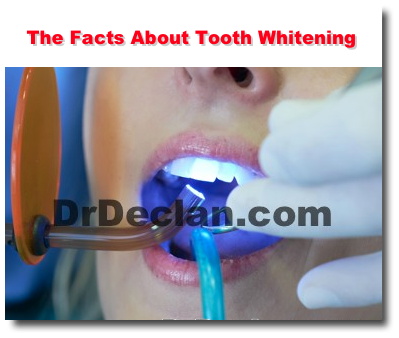The Facts About Tooth Whitening
- Tweet


With so many people wanting whiter teeth, it is no surprise that numerous options to lighten teeth have become available. Before exploring what works and what doesn't, it helps to understand how tooth whitening occurs. In the most basic sense, tooth whitening occurs when the hydrogen peroxide molecule breaks down and the resulting by-products react with the complex organic molecules (stain) in the tooth enamel to make them lighter. The important factors that influence how well the whitener will work are the concentration of the hydrogen peroxide, the stability of the hydrogen peroxide, and how long the hydrogen peroxide remains on the enamel. Unfortunately, people place all the emphasis on the concentration of the hydrogen peroxide but this only indicates its concentration when it was manufactured. Any change in pH, temperature, or contamination will greatly diminish the effectiveness of the hydrogen peroxide and may even make it dangerous, such as a decrease in pH which would make it acidic and damaging to enamel. This is why when you are choosing the best way to whiten your teeth you have to make absolutely sure you use a very high quality product so you don't damage your enamel in the process. Even high quality high concentration hydrogen peroxide is too strong to get on your delicate gums so you should never attempt to use it at home.
 As for the more mild varieties of tooth whiteners that are sold at stores, there is a lot of marketing hype to sort through. First, since the amount of time the whitener is in contact with the enamel is such an important factor, it is easy to see that whitening toothpastes have minimal whitening effect. The manufacturers claim "up to 6 shades lighter" but they created there own shade guide which basically divided the standard Vita shade guide used by dentists into extremely small increments. This means that what would be a one shade change on a standard Vita guide, which is barely noticeable, becomes a 6 shade change on their shade guide even though the real change is the same, barely noticeable. White strips and homemade trays allow you to keep the hydrogen peroxide in contact with the teeth longer but have their own disadvantages. The whitening strips don't contact all surfaces of the teeth and result in uneven whitening and also overlap onto the gums which leads to irritation. The homemade trays on the other hand are bulky and allow you to swallow a lot of the whitening gel which is also irritating to the tissues.
As for the more mild varieties of tooth whiteners that are sold at stores, there is a lot of marketing hype to sort through. First, since the amount of time the whitener is in contact with the enamel is such an important factor, it is easy to see that whitening toothpastes have minimal whitening effect. The manufacturers claim "up to 6 shades lighter" but they created there own shade guide which basically divided the standard Vita shade guide used by dentists into extremely small increments. This means that what would be a one shade change on a standard Vita guide, which is barely noticeable, becomes a 6 shade change on their shade guide even though the real change is the same, barely noticeable. White strips and homemade trays allow you to keep the hydrogen peroxide in contact with the teeth longer but have their own disadvantages. The whitening strips don't contact all surfaces of the teeth and result in uneven whitening and also overlap onto the gums which leads to irritation. The homemade trays on the other hand are bulky and allow you to swallow a lot of the whitening gel which is also irritating to the tissues.
As for dentist supervised whitening, it is important that your dental office has done a lot of these procedures and pays attention to all the details. If the gums are properly protected for in office whitening or custom trays are meticulously fabricated for home use, and along with a high quality whitener, you can expect an excellent result. I know some people say tooth whitening is merely a cosmetic procedure and doesn't make you any healthier. On the other hand, if you hate the color of your teeth and having a whiter smile makes you feel better and more vibrant, then tooth whitening may indeed improve your "health."
We offer complimentary consultations to see if whitening may be right for you. If you decide to have a more vibrant smile, we will take $50 off the treatment of your choice if
you mention this article.
ref no:8329
Please send questions about this website to webmaster
Copyright© 2008 - 2023 Declan Devereux & Associates. All rights reserved.
Terms of Use / Legal Disclaimer / Privacy Statement
Site Designed and Managed by MacBusiness Consulting
Terms of Use / Legal Disclaimer / Privacy Statement
Site Designed and Managed by MacBusiness Consulting
